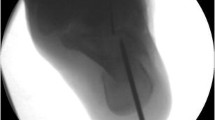Abstract
Background
Flexible flatfoot is a frequent deformity found in children. The aim of this study is to evaluate the pedographic outcome of the percutaneous arthroereisis with the use of a screw through the sinus tarsi into the talus.
Materials and methods
43 calcaneo-stop procedures of 25 patients (18 bilateral, seven unilateral) were evaluated. Mean age at surgery was 10 years (7–14, SD 2.2) (SD: standard deviation), mean follow-up time was 9.7 months (3–19, SD 5.5). Patient satisfaction rate was recorded, the Meary’s talus-first metatarsal angle was measured with lateral radiograms, and a dynamic pedographic assessment was also performed.
Results
Patient satisfaction rate was excellent for 33 feet of 19 children, good for eight feet of five children, and poor for either feet of one child. We did not observe any complications during or following the surgery.The mean rest heel valgus decreased from 13.4° (10°–17°, SD 1.5) to 2.8° (0°–6°, SD 1.7) post op. The Meary’s angle improved from 160.2° (148°–177°, SD 6.8) to 175.9° (167°–179°, SD 3.5). By pedographic analysis, the area and the pressure–time integral (load amount, PTI) values increased on the lateral regions of the sole (except for the lesser toes) and decreased on the medial areas (except for the hallux). The relative contact time in the lateral midfoot increased from 63.8% (39.6–78.4%, SD 10.6) to 75.1% (50–86.1%, SD 9.4), and that in the lateral forefoot region from 81.2% (60.4–89.2%, SD 6.6) to 86.8% (78.1–97.1%, SD 4.8).
Conclusion
The calcaneo-stop procedure is a simple and reliable method for the correction of severe flexible paediatric flatfoot. Our prospective, short-term results following the anterograde screw implantation into the talus correlate well with the results of similar or different arthroereisis methods. Further investigations are required to evaluate the long-term outcome of the screw calcaneo-stop method, including the conditions following implant removal.





Similar content being viewed by others
References
Arangio G, Reinert K, Salathe E (2004) A biomechanical model of the effect of subtalar arthroereisis on the adult flexible flatfoot. Clin Biomech 19:847–852
Staheli LT, Chew DE, Corbett M (1987) The longitudinal arch. J Bone Joint Surg 69A:426–428
Sullivan JA (1999) Pediatric flatfoot: evaluation and management. J Am Acad Orthop Surg 7:44–53
Tachdjian MO (1985) The child’s foot. WB Saunders, Philadelphia, pp 556–597
Roth S, Sestan B, Tudor A et al (2007) Minimally invasive calcaneo-stop method for idiopathic, flexible pes planovalgus in children. Foot Ankle Int 28:991–995
Schon LC (2007) Subtalar arthroereisis: a new exploration of an old concept. Foot Ankle Clin 12:329–339
Wenger DR, Leach J (1986) Foot deformities in infant and children. Pediatr Clin North Am 33:1411–1427
Staheli LT (1999) Planovalgus foot deformity. Current status. J Am Podiatr Med Assoc 89:94–99
Giannini S (1998) Kenneth A. Johnson Memorial Lecture. Operative treatment of the flatfoot: why and how. Foot Ankle Int 19:52–58
LeLivre J (1970) Current concepts and correction in the valgus foot. Clin Orthop Relat Res 70:43–55
Magnan B, Baldrighi C, Papadia D et al (1997) Il piede piatto : tecniche chirurgiche a confronto. Risultati del gruppo di studio sull’endortesi retrograda per il calcaneo stop. Ital J Ped Orthop 13:28–33
Peters PA, Sammarco J (1989) Arthroereisis of the subtalar joint. Foot Ankle 10:48–50
Smith SD, Millar EA (1983) Arthroereisis by means of a subtalar polyethylene peg implant for correction of hindfoot pronation in children. Clin Orthop 181:15–25
Verheyden F, Vanlommel E, Van Der Bauwhede J, Fabry G, Molenaers G (1997) The sinus tarsi spacer in the operative treatment of flexible flat feet. Acta Orthop Belg 63:305–309
Viladot A (1992) Surgical treatment of the child’s flatfoot. Clin Orthop 283:34–38
De Pellegrin M (2005) Die subtalare Schrauben-arthrorise beim kindlichen Plattfuβ. Orthopade 34:941–953
Kránicz J, Czipri M (2000) Korai tapasztalatok a Calcaneo-stop módszer alkalmazásával a gyermekkori lúdtalp műtéti kezelésében. Magy Traumatol Ortop 43:177–182
Jerosch J, Schunk J, Abdel-Aziz H (2009) The stop screw technique: a simple and reliable method in treating flexible flatfoot in children. Foot Ankle Surg 15:174–178
Terebessy T, Kiss S, Holnapy G, Domos Gy, Gy Szőke (2009) A calcaneus stop típusú arthrorisis eredményességének értékelése a gyermekkori flexibilis lúdtalp kezelésében. Magyar Trauma Ortop 52:245–251
Roth S (2007) Minimal invasive calcaneo-stop method in cases of pes planovalgus in childhood with BoneStar® implant. J Children Orthop 1(suppl. 1):25
Pehlivan O, Cilli F, Mahirogullari M, Karabudak O, Koksal O (2009) Radiographic correlation of symptomatic and asymptomatic flexible flatfoot in young male adults. Int Orthop 33:447–450
Burutaran J (1979) El calcaneo-stop para el tratamiento del valgo de talon infantil. Chirurg Piede 3:319–322
Milano L, Scala A (1985) La risi extrarticolare della sottoastragalica con endortesi calcaneale nel trattamento chirurgico delle deformita in valgo del calcagno. Chirurg Piede 9:303–309
Castaman E (1993) L’intervento di calcaneo-stop: storia ed aggiornamenti. Chirurg Piede 17:269–295
Giannini S, Ceccarelli F, Benedetti MG, Catani F, Faldini C (2001) Surgical treatment of flexible flatfoot in children: a four-year follow-up study. J Bone Joint Surg 83A(Suppl 22):73–79
Author information
Authors and Affiliations
Corresponding author
Rights and permissions
About this article
Cite this article
Kellermann, P., Roth, S., Gion, K. et al. Calcaneo-stop procedure for paediatric flexible flatfoot. Arch Orthop Trauma Surg 131, 1363–1367 (2011). https://doi.org/10.1007/s00402-011-1316-3
Received:
Published:
Issue Date:
DOI: https://doi.org/10.1007/s00402-011-1316-3




